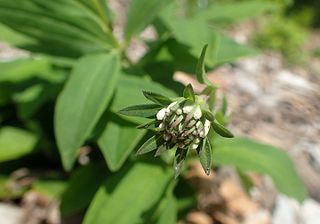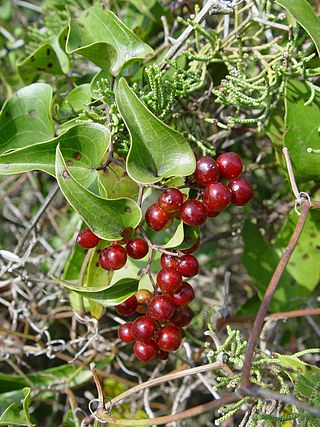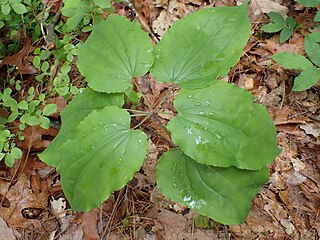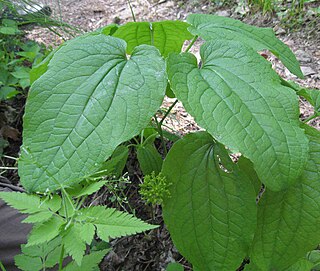
Smilax rotundifolia, also known as roundleaf greenbrier or common greenbrier, is a woody vine native to the southeastern and eastern United States and eastern Canada. It is a common and conspicuous part of the natural forest ecosystems in much of its native range. The leaves are glossy green, petioled, alternate, and circular to heart-shaped. They are generally 5–13 cm long. Common greenbrier climbs other plants using green tendrils growing out of the petioles.

Marshallia is a genus of plants in the tribe Helenieae within the family Asteraceae. Marshallia is native to the southeastern and south-central United States. A common name applied to most species in the genus is Barbara's buttons.

Smilax herbacea, the smooth carrionflower or smooth herbaceous greenbrier, is a plant in the catbriar family. It is native to eastern Canada and the eastern United States. Its preferred natural habitat is rich forests, and riparian thicket and meadows.

Smilax aspera, with common names common smilax, rough bindweed, sarsaparille, and Mediterranean smilax, is a species of flowering vine in the greenbriar family.

Smilax glauca, the cat greenbriar or catbriar is a woody vine in the family Smilacaceae. It is native to central and eastern portions of the United States as well as Mexico, where it is a common and conspicuous part of the forest vegetation.
Smilax californica, the California greenbriar, is a common woody vine native to northern California and southwestern Oregon in the western United States.

Smilax jamesii is a species of flowering plant in the greenbriar family known by the common name English Peak greenbriar. It is to northern California, where it is known from the Klamath Mountains and the southernmost peaks of the Cascade Range. It has also been reported from nearby locations in southwestern Oregon. It grows in moist areas such as lakesides and streambanks in mountain coniferous forest habitat. It was discovered to be a new species when herbarium specimens thought to be Smilax californica were reexamined.

Spiraea virginiana is a rare species of flowering plant in the rose family (Rosaceae) known by the common names Virginia meadowsweet and Virginia spiraea. It is native to the southern Appalachian Mountains, where it has a distribution scattered across nine states. However, most populations are very small and poor in quality. It is threatened by disturbances in the hydrology of its habitat, introduced species of plants, and other threats. It is a federally listed threatened species of the United States.

Smilax laurifolia is a species of flowering plant in the greenbrier family known by the common names laurel greenbrier, laurelleaf greenbrier, bamboo vine, and blaspheme vine. It is native to the southeastern United States, where it occurs along the Gulf and Atlantic coastal plains from Texas to New Jersey, the range extending inland to Arkansas, Oklahoma, and Tennessee. It also occurs in Cuba and the Bahamas.

Smilax bona-nox, the saw greenbrier, is a species of plant in the family Smilacaceae. It is native to the Southern United States, and eastern Mexico.

Smilax auriculata is a North American plant species native to the Bahamas, the Turks & Caicos Islands, and the southeastern United States. Common names include earleaf greenbrier and wild-bamboo, despite the fact that it is not closely related to bamboo. It is reported from Florida, Georgia, North and South Carolina, Alabama, Mississippi, and Louisiana. It grows on coastal sand dunes and in sun-lit locations in sandy woodlands at elevations of less than 100 m.

Smilax biltmoreana, common name Biltmore's carrionflower, is a North American plant species native to the south-eastern United States. It is concentrated in the Great Smoky Mountains but with outlying populations in Virginia, North and South Carolina, Tennessee, Kentucky, Georgia, Alabama, and northern Florida.
Smilax illinoensis , the Illinois greenbrier, is a North American species of plants found only in the United States and Canada. It is native primarily to the Great Lakes Region with a few populations farther south in Missouri and in the Ohio Valley.

Smilax lasioneura, the Blue Ridge carrionflower, is a North American species of flowering plants in the greenbriar family. It is widespread across central Canada and the central United States, from Ontario, Manitoba and Saskatchewan south to Texas, Louisiana, and Florida.

Smilax pseudochina is a perennial species of herb in the greenbriar family. It is commonly called bamboo vine or false chinaroot. Its range extends up the Atlantic Coast of the United States, from Long Island in New York State south to Georgia.

Smilax pulverulenta, the downy carrionflower, is a North American species of plants native to the eastern and central United States. The plant is fairly common in the Ozarks, the Appalachians, and the Mid-Atlantic States, with isolated populations in Rhode Island, Minnesota, and Nebraska.
Smilax pumila, the sarsaparilla vine, is a North American species of plants native to the southeastern United States from eastern Texas to South Carolina.

Smilax tamnoides, common name bristly greenbrier, is a North American species of plants native to the United States and Canada. It is widespread from Ontario and New York State south to Texas and Florida.
Smilax walteri, common names coral greenbrier, red-berried greenbrier or red-berried bamboo, is a North American species of plants found only in the United States. It is native to coastal plains in the south-central, southeastern, and east-central parts of the country, from eastern Texas to New Jersey.

Smilax ecirrhata, the upright carrionflower, is a species of flowering plant in the Greenbriar family. It is native to Ontario and to the central United States. It is found in rich, calcareous forests along floodplains. It is an herbaceous plant that has green umbels of flowers in late spring.
















